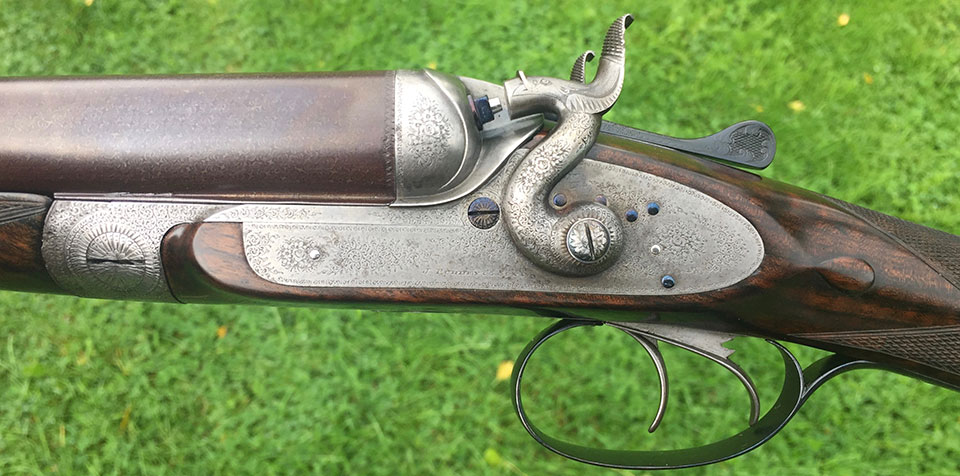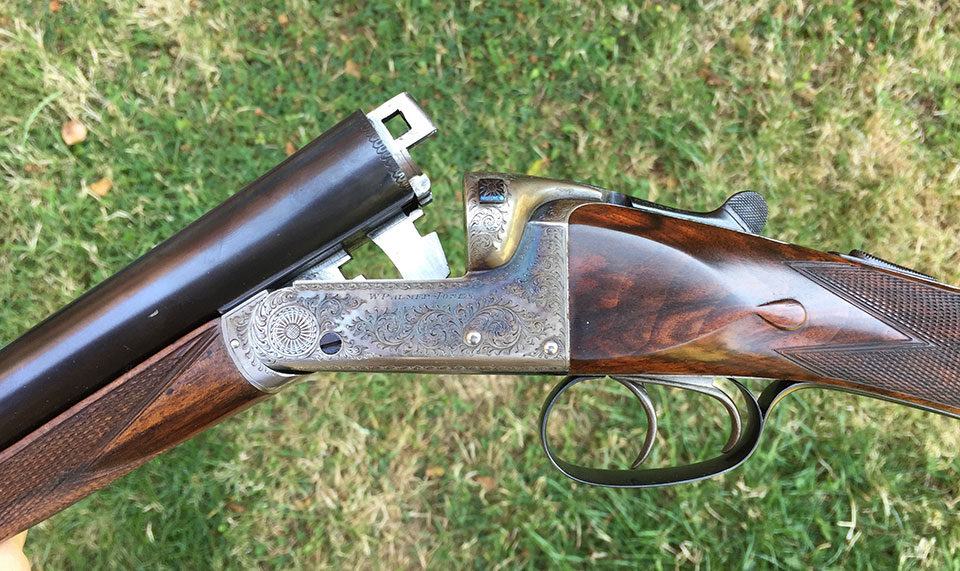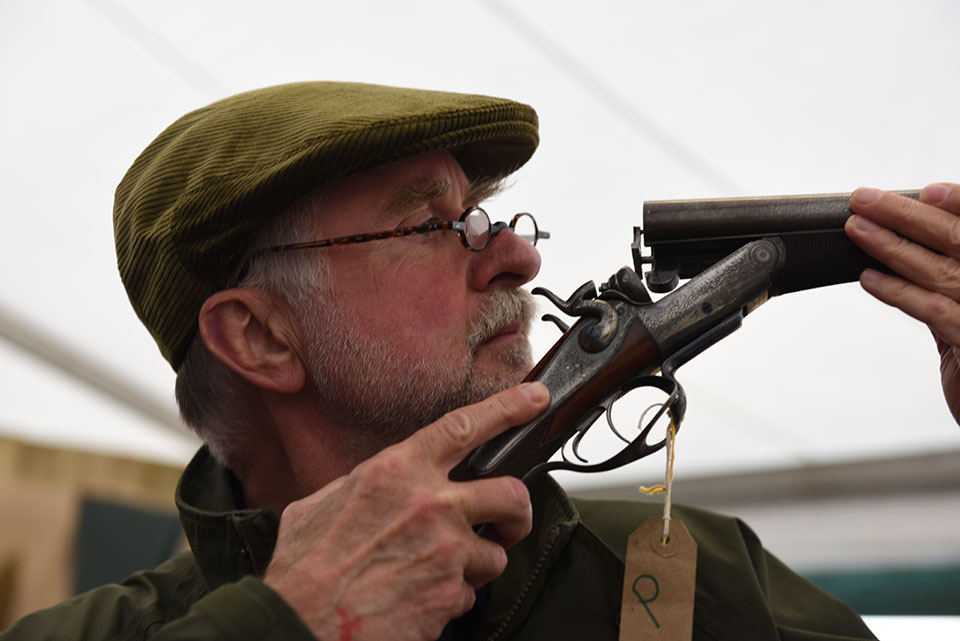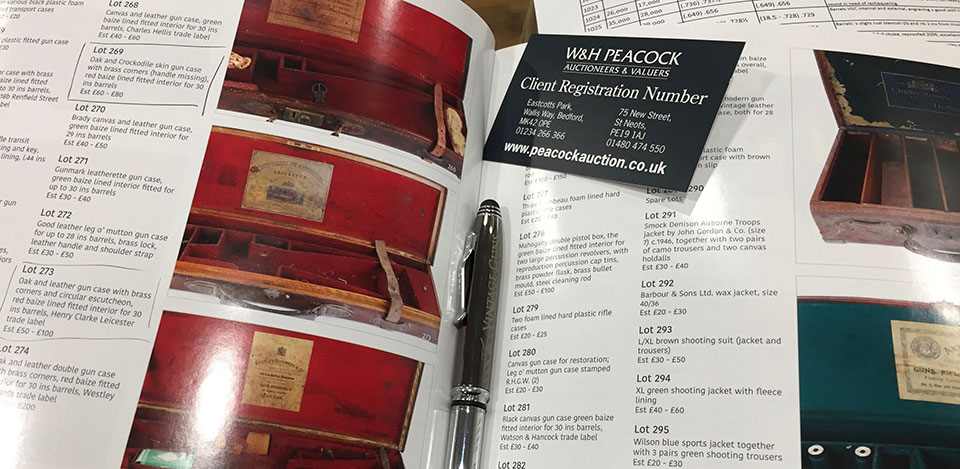Driven pheasants are so much more fun with an 1880 hammer gun.
You may be happy driving a Toyota Corolla, most people are. It is affordable, easy to drive, cheap to insure and very reliable. But have you never glanced aside with a hint of envy when someone cruises alongside in a Triumph Stag or a Jaguar Mark 2 saloon, wooden steering wheel in hand, throaty exhaust note and classic lines evoking the genteel motoring days of old, before the M25 and controlled parking zones, speed cameras and unleaded petrol?
To the shooting man, the Toyota Corolla is the Beretta Silver Pigeon; nothing wrong with it for the money, but what about those exotic thoroughbreds that occasionally get un-slipped in your presence? Guns with laterally associated barrels, side-locks or external hammers? Have you never wondered how life might be different with a piece of classic shooting iron in hand on that pheasant drive?
What’s the point?
Like a classic car, a vintage British shotgun makes life a little more interesting. They were made by hand, from the finest materials available, by men who worked at the bench from their mid teens until their dotage and feature design and engineering solutions that were cutting edge in their day. The quality of manufacture is often astounding and could not be re-produced today in guns approaching the price range in which you are shopping. Every gun is hand engraved, some are astoundingly beautiful. Consider that even a standard modern engraving commission for a gun costs upwards of six thousand pounds and you will begin to see the depth of quality and value in the classic market.
Fit and finish, balance and shape, longevity and beauty. all these merge seamlessly into your classic gun. Even when you are not shooting it, you will appreciate the character it has and the spirit of a bygone age that it embodies, as you wait for the first flush of the drive or scan the horizon for signs of incoming pigeons or grouse.
Nostalgia is a drug for some, it imbues objects with character and meaning, even humble mid-quality Birmingham guns were the flag bearers of Empire, when Birmingham supplied the world with the best firearms available at any price point. Wondering where you gun has been, who has held it, what adventures it has contributed to, all these thought inject some magic into wood and steel. But remember, these are not the key issue – the key issue is that nothing handles like a British shotgun. Once, I offered my Purdey to a friend for the last drive of the day. He came back grinning from ear to ear “it just shoots where you look” he said and promptly sold his Gold E to replace it with a Holland & Holland hammer gun.
Sensitive to price?
I started my interest in old guns as a schoolboy. My friends used to find them in farm sheds and barns and give them to me. I’d soak the rusty old things in oil and strip them, learning how they were made and how they worked along the way. Webley bolt-action garden guns, old Lincoln Jeffries or Gem air rifles, it mattered not, I got pleasure from them all.
Even today, there are interesting guns for all budgets. Webley bolt action .410s are still available – the de luxe model is the nicest and they can still be had for a few pounds, likewise old hammer single barrel shotguns. They are not much in demand and offer great quality for little outlay.
If you have a few hundred pounds, look at hammer guns with under-levers, as they are less expensive than top-lever or other snap action types. A bit of practice and they are almost as fast to use, and you’ll soon stop noticing even that. Alternatively, look for a sound boxlock, they are cheaper now than they have ever been and less than a grand will get you something interesting as well as practical.
Some examples of guns on offer today, from low to high.
£50 Webley & Scott .410 bolt action
£100 E.M Reilly 12-bore single barrel hammer gun.
£500 Cogswell & Harrison ‘Avant Tout’ 12-bore boxlock ejector.
£1,000 Webley & Scott 700 model 12-bore boxlock ejector.
£1,500 G.E Lewis 3” magnum 12-bore boxlock non-ejector.
£2,000 Cashmore 20-bore top-lever hammer gun.
£3,000 Trulock & Harris 12-bore sidelock ejector.
Investment grade guns can run into the tens of thousands of pounds. A best hammer gun in top condition might cost you well over £10,000 and an immaculate, top-brand 1930s London side-lock can fall into the £15,000 – £40,000 bracket.
Worried about ammunition?
Most quality breech-loaders can take nitro proof.
Most English guns made prior to WW2 will have 2 1/2” chambers. We are spoilt in this country in having huge choice from all the major manufacturers. Performance is on a par with 70mm ammo and prices the same, broadly speaking. Order some Eley ‘Grand Prix’, Hull ‘Imperial Game’ or Gamebore ‘Pure Gold’ and you are good to go. Need a bit more punch? Eley ‘Maximum’ is a 2 1/2” case with a bit more payload, ideal for ducks. There is no need to worry about good, modern ammunition; either from a supply or performance stand point.
Concerned about your investment?
It is hard to lose money on a wisely bought and well cared-for English gun in the long term. Consider buying an 1890 Purdey for £9,000. A new one is basically the same thing and will cost you close to £100,000 today. The old one did all it’s depreciation decades ago; inflation and supply and demand take care of the rest. Keep it in good shape, shoot it for ten years, you will get your money back, you may well make a profit.
Never used a side-by-side or double triggers?
It never ceases to amaze me how many people I know who operate complex machinery, drive cars in different countries, play sport, even fly helicopters – but swear they can’t adjust to double triggers. It takes one morning at the clay ground with your new gun. A ritual of visually registering what you have in your hand and a little mindfulness. There is no secret, that is it. With a little effort you will learn how to swap from one mechanism to another without issue. Single trigger, double trigger, ejector, non-ejector, hammer, hammerless, top-lever, side-lever, under-lever. I pick them up one after the other and there is no issue, just a seamless transfer from one to the other. All it takes is little focus, relaxation and practice.
Worried about getting it wet?
Get your gun out on the moor where it belongs.
British guns were made for British weather. I was once out on a farm shoot when a beater noticed my Purdey and asked what I was doing with it on a rough old shoot like this on a wet day in November. It is not an issue – take it out, shoot it, get it wet and dirty if necessary, than take it home, dry it, clean it and put it away none the worse for its outing.
Buy quality.
This is especially true if you are thinking of restoring a gun. Everything you do will cost about the same, regardless of the gun being restored. Re-blacking a Boss costs the same as re-blacking a Bland. Re-jointing a Grant sidelock is the same outlay as doing it to an Army & Navy boxlock. Considering the optimum potential resale value of the guns in question, the higher quality piece will re-pay our investment better in the long term. You may be surprised at the accumulated value of the hardly-ever-used guns in your gun cabinet. Rather than have five grand tied up in ten low quality guns, wouldn’t it be better to put all that cash into one nice English gun that you will actually use and which will hold its value?
Where to buy?
We can help you traverse the challenges of the auction room.
Private sales, gun dealers or auction rooms? Private sales can be the best, but you need to know what you are buying. I recently valued collection built up over the years by a gentleman. There were hammer guns of nice quality by the best makers of the day and all looked presentable, having been bought in private deals and through friends. Out came my bore gauge and wall measuring jig. Three of the guns were out of proof, one had walls don to sixteen thou’ and another was ten thou’. anything under twenty thou’ is drastically devalued and under eighteen impossible to sell. Rather than being worth thousands of pounds, the collection was a liability and worth a fraction of the expectation.
Buying from a dealer, at least a reputable one, gives peace of mind. He will give you all the specifications and you will have a come-back if he has misrepresented the gun. A good dealer will advise you about the right gun for your needs, make sure it is sound and that you have the right information about the best ammunition and have look at fit and make any necessary alterations.
Auctions are exciting but prices at auction now approach, or exceed, many retail sales; with the auctioneer taking as much as 30% from the sale, while many dealers will make just 10% or 20% to turn a trade-in gun quickly. Also, the auction offers no protection from poor purchases. Everything is ‘sold as seen’ and the buyer is responsible for his bid, whatever may transpire regarding problems with the gun later.
Published by Vintage Guns Ltd on (modified )




